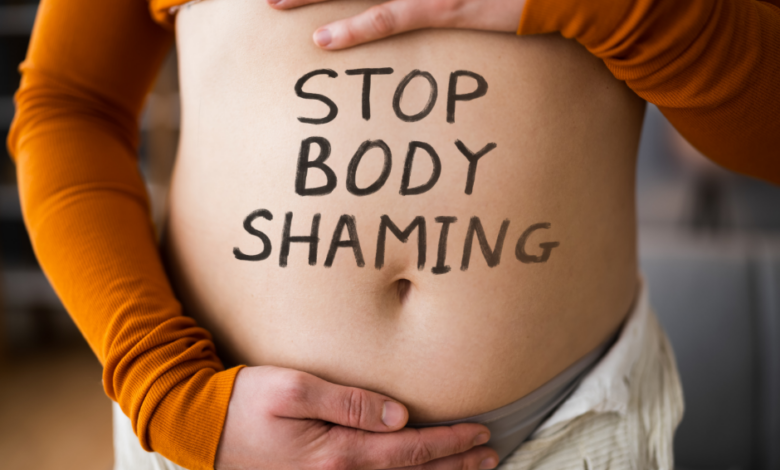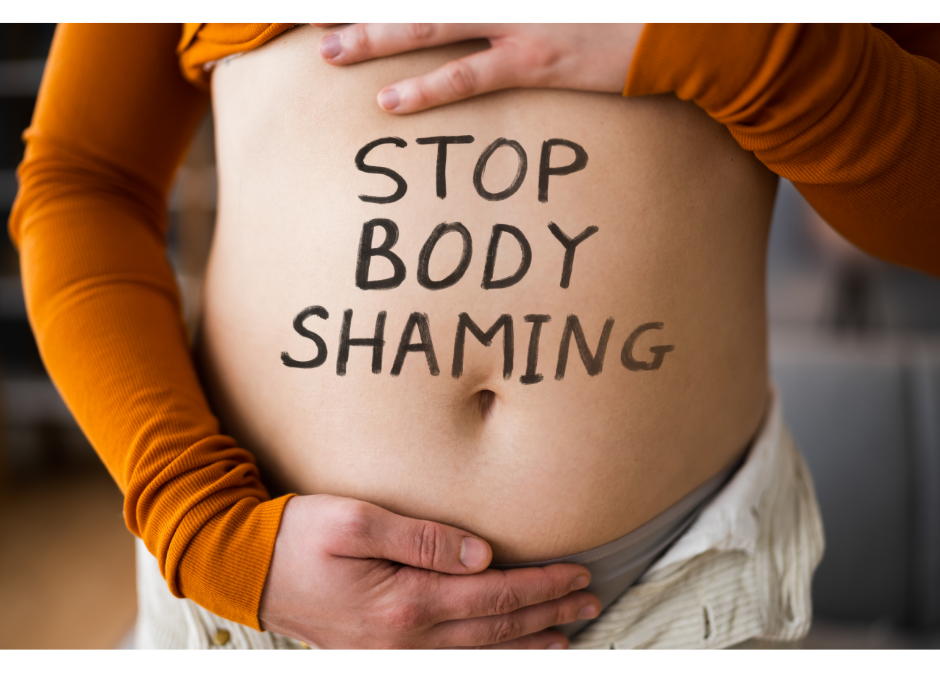
How to Break Your Body Shaming Habit
How to break your body shaming habit? It’s a question many of us grapple with, navigating a world that often bombards us with unrealistic beauty standards. Body shaming can chip away at our self-esteem, leaving us feeling insecure and anxious.
But the good news is, breaking free from this harmful habit is possible. This journey starts with understanding the root of body shaming, identifying your triggers, and developing strategies to challenge negative thoughts.
We’ll explore practical techniques to cultivate self-compassion, shift your focus away from appearance, and embrace body neutrality. By building a supportive community and surrounding yourself with positive influences, you can create a healthier relationship with your body and reclaim your confidence.
Challenging Negative Thoughts
Body shaming often stems from negative thoughts and beliefs about our bodies. These thoughts can be deeply ingrained and difficult to challenge, but with practice, we can learn to identify and replace them with more positive and realistic ones.
Breaking free from body shaming starts with shifting your focus from how you look to how you feel. Instead of obsessing over the number on the scale, consider improving your overall fitness by understanding your VO2 max. Learn more about what VO2 max is and how to improve it , and you’ll discover that a stronger, healthier body is a far more powerful source of self-confidence than any fleeting image in the mirror.
Cognitive Distortions
Cognitive distortions are patterns of thinking that lead to negative and inaccurate interpretations of reality. In the context of body shaming, these distortions can manifest in various ways, often leading to self-criticism and dissatisfaction.
- All-or-Nothing Thinking:This involves viewing situations in extreme, black-and-white terms. For example, “If I don’t fit into this size, I’m a failure.”
- Overgeneralization:This distortion involves drawing broad conclusions based on a single event or experience. For example, “I didn’t get a compliment on my outfit today, so I must be unattractive.”
- Mental Filter:This involves focusing only on negative aspects of a situation while ignoring the positive ones. For example, focusing solely on perceived flaws in your body while ignoring your strengths and accomplishments.
- Disqualifying the Positive:This distortion involves dismissing positive experiences or feedback as irrelevant or insignificant. For example, discounting compliments about your body by saying, “They’re just being nice.”
- Jumping to Conclusions:This involves making assumptions without sufficient evidence. For example, assuming people are judging your body based on their fleeting glances.
Building Self-Compassion
Imagine a friend who constantly criticizes you, puts you down, and makes you feel inadequate. Would you tolerate such behavior? Likely not. Yet, many of us treat ourselves with far less kindness and compassion than we would offer a friend.
This is where self-compassion comes in – a powerful tool for overcoming body shaming and fostering a healthier relationship with ourselves.
Breaking the habit of body shaming yourself starts with recognizing the negativity and replacing it with self-compassion. A strong core is essential for good posture and overall well-being, and it’s crucial to train it effectively. Make sure you’re avoiding common mistakes by checking out this helpful article: 10 mistakes to avoid when training your core.
Remember, building a strong core is a journey, not a destination, and it’s important to approach it with patience and kindness towards yourself.
Benefits of Self-Compassion
Self-compassion, the act of treating ourselves with kindness, understanding, and acceptance, can significantly contribute to overcoming body shaming. When we practice self-compassion, we recognize that everyone struggles, including ourselves, and we treat ourselves with the same empathy and support we would offer a loved one.
This can help us:
- Reduce negative self-talk and body image dissatisfaction.
- Boost self-esteem and confidence.
- Increase resilience and coping skills in the face of challenges.
- Promote emotional well-being and reduce stress and anxiety.
Cultivating Self-Compassion
Cultivating self-compassion is a journey, not a destination. Here are some practical exercises to begin this journey:
Self-Kindness
- Mindful Self-Talk:Replace negative self-talk with kind and supportive messages. For example, instead of saying, “I’m so fat,” try saying, “I’m struggling with my body image right now, but I’m working on it.”
- Positive Affirmations:Regularly repeat positive affirmations about your body and yourself. For example, “I am worthy of love and acceptance, just as I am.”
Common Humanity
- Acknowledge Shared Experiences:Remind yourself that everyone experiences body image struggles. You are not alone.
- Connect with Others:Seek out support from friends, family, or support groups who understand what you’re going through.
Mindfulness
- Body Scan Meditation:Gently scan your body, paying attention to sensations without judgment. Notice any areas of tension or discomfort, and offer them kindness and acceptance.
- Mindful Eating:Pay attention to your body’s hunger and fullness cues. Eat slowly and savor each bite.
Seeking Support
Breaking free from body shaming can be a challenging journey, and having a support system can make a world of difference. You don’t have to navigate this alone. Seeking support can provide you with valuable tools, understanding, and encouragement to cultivate a healthier relationship with your body.
Breaking the habit of body shaming starts with self-compassion. Instead of focusing on what you perceive as flaws, try shifting your mindset towards appreciating your body for all it does for you. A great place to start is with small, achievable changes, like incorporating more movement into your daily routine – check out my your 10 point summer countdown to a healthier you for some inspiring ideas! Remember, health is about more than just size, it’s about feeling good in your own skin, and that’s a journey worth taking.
Therapy for Body Image Concerns
Therapy can be a powerful tool for addressing body shaming and self-esteem issues. A therapist can provide a safe and confidential space to explore the roots of your negative thoughts and feelings about your body. They can help you develop coping mechanisms, challenge self-critical beliefs, and build a more positive body image.
Support Groups and Online Communities, How to break your body shaming habit
Connecting with others who share similar experiences can provide a sense of belonging and validation. Support groups offer a space to share your struggles, gain insights from others, and learn from their experiences. Online communities can provide a platform for anonymous connection, allowing you to engage in discussions, share resources, and find encouragement from people who understand what you’re going through.
Finding a Therapist Specializing in Body Image
When seeking a therapist, look for someone who specializes in body image concerns. You can ask your primary care physician for referrals or search online directories for therapists with expertise in eating disorders, body dysmorphic disorder, or other body image issues.
- Consider their approach:Some therapists may use cognitive-behavioral therapy (CBT) to challenge negative thoughts, while others may focus on mindfulness or body acceptance techniques.
- Look for a good fit:It’s important to find a therapist with whom you feel comfortable and connected. Trust your instincts and don’t be afraid to try a few different therapists until you find one who resonates with you.
Shifting Your Focus
Breaking the body shaming habit isn’t just about changing your thoughts; it’s about shifting your attention away from your appearance and toward the richness of life’s experiences. When you focus on your worth beyond your physical form, you unlock a world of possibilities and discover a sense of fulfillment that goes far beyond superficial standards.
Exploring Life Beyond Appearance
Shifting your focus from your appearance to other aspects of your life can be a powerful way to break free from body shaming. When you stop constantly scrutinizing your reflection, you open up space to explore your passions, cultivate meaningful relationships, and pursue your goals.
It’s about embracing the totality of who you are – your talents, your values, your experiences, and your unique perspective.
Prioritizing Self-Care and Well-being
Prioritizing self-care and well-being is a fundamental step in shifting your focus. This involves nurturing your physical, mental, and emotional health. Engaging in activities that nourish your spirit and bring you joy can help you break free from the cycle of body shaming.
Examples of Self-Care Activities:
- Engaging in physical activities you enjoy:Dance, swim, hike, or play a sport – choose activities that make you feel good, not just those you think you “should” do.
- Practicing mindfulness and meditation:These practices help you become more aware of your thoughts and feelings, allowing you to challenge negative self-talk and cultivate a sense of peace.
- Spending time in nature:Connecting with nature has been shown to reduce stress and improve mood. Take walks in the park, go for a hike, or simply sit in your garden and enjoy the fresh air.
- Connecting with loved ones:Strong social connections are crucial for well-being. Spend time with friends and family, engage in meaningful conversations, and nurture your relationships.
- Pursuing hobbies and interests:Devote time to activities that bring you joy and fulfillment, whether it’s painting, writing, playing an instrument, or learning a new skill.
Celebrating Your Strengths and Accomplishments
Instead of dwelling on perceived flaws, shift your focus to celebrating your strengths and accomplishments. Acknowledge your unique talents, skills, and contributions to the world. This positive self-talk can help you build self-confidence and break free from the grip of body shaming.
Strategies for Celebrating Your Strengths:
- Keep a gratitude journal:Each day, write down three things you’re grateful for, focusing on your personal qualities and achievements.
- Practice affirmations:Repeat positive statements about yourself, such as “I am strong,” “I am capable,” and “I am worthy.” This helps reprogram your subconscious mind to believe in your value.
- Set realistic goals and celebrate milestones:Break down your goals into smaller steps and celebrate each achievement along the way. This builds momentum and reinforces your belief in your abilities.
- Seek out positive feedback:Ask friends, family, or mentors for their honest opinions about your strengths and accomplishments. Their positive feedback can help you see yourself in a new light.
- Focus on your values:Identify your core values and live your life in alignment with them. This sense of purpose and meaning can help you feel more fulfilled and confident in your own skin.
Embracing Body Neutrality: How To Break Your Body Shaming Habit
Body neutrality is a powerful approach to shifting your relationship with your body. Instead of striving for a specific body size or shape, it encourages you to appreciate your body for what it does, not what it looks like. This shift in focus can lead to increased self-acceptance, reduced body shame, and a healthier overall relationship with yourself.
Benefits of Body Neutrality
Body neutrality offers numerous benefits for your physical and mental well-being. It can help you:
- Reduce body dissatisfaction and negative self-talk.By focusing on your body’s functions rather than its appearance, you can lessen the pressure to conform to societal beauty standards and reduce the impact of negative thoughts.
- Improve your self-esteem and confidence.Accepting your body for what it is, regardless of its size or shape, can boost your self-esteem and confidence in other areas of your life.
- Enhance your overall health and well-being.By focusing on nourishing your body and engaging in activities that feel good, you can promote a healthier lifestyle and reduce the stress associated with body image concerns.
- Promote a more positive relationship with food.Body neutrality encourages a mindful and balanced approach to food, focusing on nourishing your body rather than restricting or punishing it.
Cultivating a Neutral Relationship with Your Body
Shifting your focus from body image to body function can be a gradual process. Here are some practical tips to cultivate a neutral relationship with your body:
- Practice gratitude.Take time each day to appreciate your body’s capabilities, such as walking, breathing, or feeling the sun on your skin. This practice can help you shift your focus from your appearance to your body’s inherent strengths.
- Challenge negative self-talk.Pay attention to the thoughts you have about your body. When you notice negative self-talk, gently challenge it and replace it with more positive and neutral thoughts.
- Engage in activities you enjoy.Focus on activities that make you feel good, regardless of how they might affect your appearance. This could include dancing, swimming, hiking, or simply spending time in nature.
- Dress for comfort and function.Choose clothes that feel good on your body and allow you to move freely. Avoid clothing that makes you feel uncomfortable or self-conscious.
- Avoid comparing yourself to others.Remember that everyone is unique and beautiful in their own way. Comparing yourself to others only fuels body dissatisfaction and negative self-talk.
Resources and Information on Body Neutrality
There are many resources available to help you learn more about body neutrality and how to cultivate a more positive relationship with your body. Some helpful resources include:
- Books: “Body Kindness”by Rebecca Scritchfield, “Intuitive Eating”by Evelyn Tribole and Elyse Resch, “The Body Positive”by Connie Sobczak and Lucy Delap, and “The F*ck It Diet”by Caroline Dooner.
- Websites:The Body Positive, National Eating Disorders Association (NEDA), Intuitive Eating, and Health at Every Size (HAES).
- Social Media:Follow body neutrality advocates and influencers on platforms like Instagram, TikTok, and YouTube.
Creating a Positive Body Image
Building a positive body image involves more than just thinking positive thoughts; it’s about actively challenging the negative messages we receive from society and internalizing a more realistic and compassionate view of our bodies.
The Role of Media and Social Media
The media and social media play a significant role in shaping our perceptions of ideal body types. We are constantly bombarded with images of seemingly perfect bodies, often digitally enhanced or filtered, which can create unrealistic expectations and contribute to body dissatisfaction.
This relentless exposure can lead to negative self-comparisons and feelings of inadequacy.
- The thin ideal:The media often promotes a thin ideal, which can be particularly damaging for individuals who do not conform to this standard. Studies have shown a strong correlation between exposure to thin ideal media and body dissatisfaction, disordered eating, and negative body image.
- Social media and unrealistic beauty standards:Social media platforms are often filled with highly curated images and videos that present an idealized version of reality. The constant exposure to these images can lead to feelings of inadequacy and pressure to conform to these unrealistic beauty standards.
- Body shaming and negative messaging:Social media can also be a breeding ground for body shaming and negative messaging. While some platforms have implemented measures to combat these issues, they still persist, contributing to a culture of self-criticism and body negativity.
Cultivating a Body-Positive Community

Surrounding yourself with supportive individuals who champion body positivity is crucial for your personal journey towards self-acceptance. A body-positive community can provide a safe space for you to express your thoughts and feelings without judgment, offering encouragement and validation as you navigate your body image challenges.
Creating a Body-Positive Environment
Creating a body-positive environment involves fostering a culture of respect and inclusivity in your personal and professional life. It’s about promoting positive self-talk and encouraging others to do the same.
- Practice mindful communication: Be mindful of the language you use when discussing bodies, both your own and others. Avoid using negative or judgmental terms. Instead, focus on celebrating diversity and individuality.
- Challenge negative stereotypes: Actively challenge negative body stereotypes in your social circles. This can involve speaking up against fatphobia, promoting diverse representations of beauty, and celebrating different body types.
- Create safe spaces: Encourage open and honest conversations about body image in your personal and professional settings. This can involve starting a book club focused on body positivity, organizing workshops on body image, or simply creating a safe space for people to share their experiences.
Examples of Body-Positive Organizations and Initiatives
Numerous organizations and initiatives are actively promoting body positivity and advocating for body acceptance. These groups offer resources, support, and community for individuals seeking to challenge societal beauty standards.
- The National Eating Disorders Association (NEDA): NEDA provides resources, support, and advocacy for individuals struggling with eating disorders and body image issues. They offer online resources, support groups, and educational materials to promote body acceptance and healthy body image.
- The Body Positive: The Body Positive is a non-profit organization dedicated to promoting body acceptance and challenging negative body image. They offer workshops, online resources, and a supportive community for individuals seeking to embrace their bodies.
- The National Association to Advance Fat Acceptance (NAAFA): NAAFA is a non-profit organization advocating for the rights and acceptance of fat people. They provide resources, support, and advocacy for individuals facing discrimination and prejudice based on their weight.
Last Recap
Breaking free from body shaming isn’t a quick fix, but it’s a journey worth taking. Remember, you are worthy of love and acceptance, regardless of your size or shape. By actively challenging negative thoughts, nurturing self-compassion, and focusing on your overall well-being, you can build a more positive and fulfilling relationship with your body.






